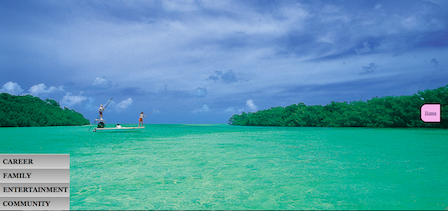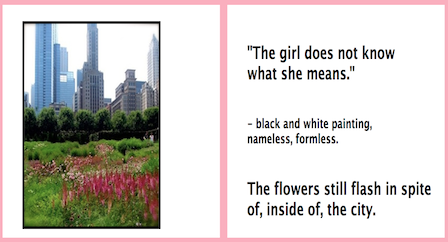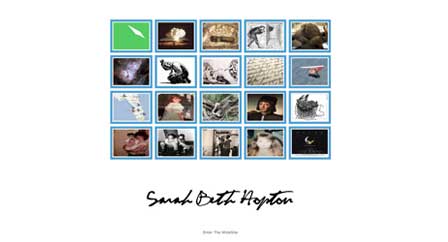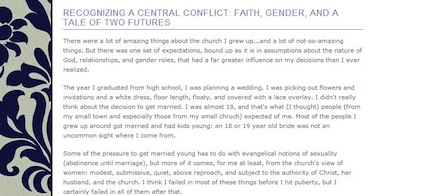Our [Electrate] Stories
Explicating Ulmer's Mystory Genre
Marc C. Santos, Ella R. Bieze, Lauren E. Cagle, Jason C., Zachary P. Dixon, Kristen N. Gay, Sarah Beth Hopton, Megan M. McIntyre
Mystory
“The method of asking you to do something before you know how to do it continues in this chapter” (Ulmer, 2003, p. 246).
Thus far this webtext has concerned itself with exploring why one might want to experiment with the mystory genre rather than explicating what a mystory is. Such explication will be the goal of this section. As we noted in the introduction, the mystory is composed of four different units, each exploring the student's investment and experiences within a particular discursive field: career, family, entertainment, and community/school. The first two are fairly self-explanatory: in the career discourse, students are asked to make a website that documents an important discovery in their career or major. The family discourse assignment asks them to make a website documenting a prominent childhood memory. The entertainment assignment asks them to make a website “documenting the details of a movie or TV narrative some part of which you still remember from your childhood years” (Ulmer, 2003, p. 127). Finally, the school assignment, the most complex of the four, prompts students to interrogate the history found in traditional textbooks against the more idiosyncratic, subjective experience unearthed by the mystory process.
Taken together, the four discourse assignments of the mystory hope to reveal to a student his or her wide image, what Gregory L. Ulmer (2003) described as the "core image guiding their creativity" (p. 10).
While the ideological work these assignments inspire can be quite sophisticated, the assignments themselves are deceptively simple; take, for instance, the career discourse assignment: "Make a website documenting an important discovery, or a (founding) invention in your career domain (your university major, or a field of disciplinary knowledge in which you have some interest)" (Ulmer, 2003, p. 21).
Ulmer augmented this rather sparse description with a bulleted list of recommendations, though their theoretical density likely problematizes, rather than clarifies, the expected outcome. Here are two of those bullets:
We will make a series of individual websites, devoted to different areas or institutional experiences, and look for the “constellation” pattern that constitutes the wide image at the end of this process. You likely will notice potential patterns as soon as you start the second assignment, and this awareness of an emergent shape (eidos) should be allowed to contribute to the selection of materials to include.
This first assignment resembles a conventional research topic, except that rather than being asked to form an argument, you are considering the material in terms of your identification with it: an event in a field of knowledge used as a feature in a self-portrait. (Ulmer, 2003, p. 22)
After closer inspection of the prompt, students begin to realize that Ulmer has not addressed some of the more obvious questions: What kind of website is a mystory? What is the voice of a mystory? Is the mystory a personal reflection or an authoritative exposition? This oversight is strategic and postpedagogical; it pushes the questions on the students to invent for themselves.[10] It attempts to liberate students from the idea, amplified by our era of increased standardized testing, that there is one answer—an answer to be discovered rather than created.[11] The purpose and power of Ulmer's postpedagogical project is to invest students in the possibility of inventing new, localized, contingent, and multiple answers. Byron Hawk (2007) noted that the ambivalence between the personal and the academic represents Ulmer’s attempt to disrupt the expectation that a “student reject his or her culture before starting to enter academic culture. Instead, it uses each person’s background as a way of situating him or her in cultural and disciplinary discourses” (p. 236). To return to the theoretical discussion of the previous section, this is another way of rethinking Ulmer’s relationship with expressivism: rather than attempting to discover the underlying authentic individual, Ulmer uses individual experiences and memories as a lens for understanding cultural dynamics and inventing new forms of expression.
Students are often disoriented by Ulmer’s use of disciplinary jargon and penchant for crafting neologisms (often times it is difficult to determine when the former ends and the latter begins). Furthermore, many are overwhelmed by the frequency and depth of his theoretical references. Rather than providing explicit instruction or concrete examples, Ulmer introduces assignments alongside what he terms “relays,” passages of text that operate as inspiration rather than example. Relays can be excerpts from literature or poems, pieces of philosophy or critical theory, or short lectures on a critical concept from ancient rhetoric or contemporary aesthetics. Students work to invent the new expressive and aesthetic practices for electracy by transforming, rather than merely executing, these traditional practices of literacy. Similarly, on a smaller scale, students are expected to invent, rather than follow, the rules and guidelines for an assignment (although Ulmer notes in the introduction that such invention can be a class, rather than individual, activity).
In addition to the relays and lectures, each larger discursive assignment contains a number of shorter exercises intending to aid the inventive process. Ulmer derives these exercises from postmodern art and/or poststructuralist theory. For example, the Career Discourse assignment included an exercise called “Counter-Dictionary”: “using Bataille as a model, compose an anti-definition entry for his Critical Dictionary” (Ulmer, 2003, p. 40). The exercise is preceded by a short lecture on antidefinition (centered around Diogenes’s performance in distinction to Socrates’ wisdom), a brief description of Georges Bataille’s project, and a few examples from Bataille’s (1929) Critical Dictionary. What Ulmer doesn’t do, however, is explicate how the Critical Dictionary connects to the larger career discourse assignment—students are left (or, when teaching undergraduates, prompted) to consider this connection themselves.
Ulmer’s text is quite theoretically dense, and a number of students—even graduate students—indicated that they often did the activity so they could understand the theory (rather than using the theory to inspire their practice). The mystory is meant to be a challenge—to both explore one’s self in relation to the cultural networks one traverses and to participate in a new pedagogical situation in which expectations and procedures are invented as a part of the assignment rather than determined and delivered beforehand. As one can imagine, this can be a very disorienting activity. The rest of the webtext explores the reactions of seven graduate students to this disequilibrium. The webtext’s final section offers advice to those seeking to engage Ulmer’s mystory project.





